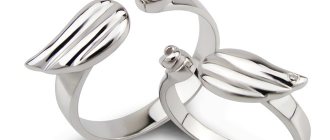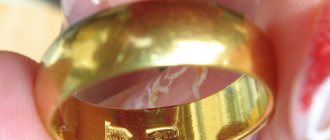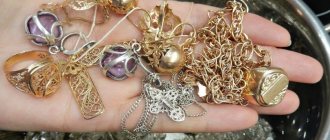June 3, 2021
Testing gold for authenticity is one of the mandatory and not always simple procedures that every owner of jewelry and other accessories made of precious metal should be able to carry out. Unfortunately, along with production technologies, methods of counterfeiting gold products are also being improved. Today, no one is immune from being deceived by an unscrupulous seller, so you need to know at least a few home inspection methods.
In this article, you will learn how to identify real gold, how it differs from a fictitious shiny alloy, and how to conduct a quick test without leaving home.
Ways and means
They were able to determine the composition of precious metals even before complex analyzers were invented. There are simple but effective methods for testing the gold content of alloys. It is most difficult to distinguish gold-plated products, but even in this case you can choose a method.
Authentication is based on simple chemical reactions, using reagents that can be found in any kitchen or medicine cabinet. They also take into account the physical properties of the substance. These tips will come in handy when purchasing jewelry without accompanying documents.
Smell test
It's worth sniffing the product. A real precious metal should not emit a scent. If you can smell it, it means it's jewelry. Silver and its alloys can also smell like iron.
Some materials used for inexpensive accessories emit odors during oxidation. It is enough to vigorously rub the object in your hands. You can pre-moisten it with plain water.
Identification by sound
You can check the precious metal by the sound of it falling on a hard surface (laminate, countertop, tile). If the ringing is dull and low, it means there is emptiness or foreign objects inside the ring or earring.
This method is not 100% reliable, because not everyone has keen hearing. But for comparison, you can throw a ring into a glass and listen to the ringing sound it makes. Products made from other types of metal do not sound such pure notes.
Testing in light and shadow
Jewelers make jewelry from 3 types of gold - yellow, white and red (pink). The shade of the noble alloy depends on other metals added to pure gold to make it harder. Such satellite metals are called alloys:
- Metal without impurities of bright yellow color.
- The white tint is obtained by alloying with silver, zinc, palladium and other elements.
- Copper as an alloying element produces a pink color.
Regardless of the color, if you look at the jewelry in different lighting (in the shade and in the sun), you will notice that it always shines. The brightness of the shine depends on the gold content in the alloy, which is designated as a breakdown.
Joints and stamps
Joints, numbers and other decorative elements must be clear, especially the proof stamp. It is worth taking a photo of the stamp and examining it carefully under magnification or using a magnifying glass.
There is often a difference in color between the individual links and the lock in the chain. Craftsmen use solder of a higher standard to make connections, which means the color will be slightly different. This is fine.
Rye bread crumb
You need to stick the moistened crumb of rye bread around the golden object. Then wait for the bread slurry to dry completely. After breaking the crust, pull out the ring and inspect its trace.
If dark spots appear inside the crumb, this indicates oxidation of the metal. Noble metal does not oxidize even in alloys. But the method will not work for fake gold-plated silver.
We recommend: The second life of an old sheet: we make a rug, pillowcases, a pet bed
Ceramic testing
You can run the jewel across tiles or porcelain. There should be thin traces of gold on their surface. If they are black or gray, they are fake.
Don't press too hard on the item. It is better to “draw” with the clasp or the back of the product. This way, the small scratches that inevitably appear with this method will not be noticeable.
Iodine Trace Analysis
To determine gold using iodine at home, you will need a cotton swab, a plate, alcohol, a cloth and iodine. The product must first be wiped with alcohol.
Dip the stick into the iodine solution and apply it to the object. If the trace is light in color, it is brass or copper. If the spot is dark, it is gold. After the experiment, polishing is necessary to remove marks.
Reaction with vinegar
Gold does not react chemically with vinegar. An object of suspected gold is placed in a container containing this substance. Fake precious metal will change color. Vinegar can be safely used to clean any stains from gold items.
When working with concentrated acid, it is worth remembering safety precautions. Vapors and splashes of the substance irritate the mucous membranes and cause skin burns.
Special reagents
Gold is checked at a pawnshop using a silicon slate (touch stone). After contact, a little precious metal remains on the stone, which reacts with the acid. If the trace has evaporated, it is a fake; if it remains, it is real gold.
Determination by magnet
Gold is diamagnetic, meaning a magnet does not affect it in any way. If the product attracts attention, then it is a fake. A magnetic bar of sufficient size is required; a souvenir bar is not suitable for this purpose.
lapis pencil
A lapis pencil based on silver nitrate on gold should not leave marks. Other metals react with it, causing dark spots to appear. This method is not suitable for fake silver.
Chemical cleaning variations
After we have thoroughly washed our gold or silver and have not achieved the desired result - stains still exist - we proceed to radical cleansing measures. These measures are very effective compared to a solution of soap or powder.
Chemical products include ammonia solution, hydrogen peroxide, sodium thiosulfate, etc. Despite the complex names of some products, they are all very common and can always be purchased freely in pharmacies or hardware stores.
1. Ammonia. A favorite product of conscientious housewives for high-quality and quick cleaning of windows, adding shine to glass and crystal dishes. The excellent properties of ammonia - an alcoholic solution of ammonia - will also be useful for our procedure.
To carefully clean your favorite product, you need to dilute the concentration of the caustic substance. We will need moderately hot water, 10-20 ml of ammonia and any washing liquid to soften the solution. Again, you need to soak the jewelry in the resulting substance for several hours or even longer.
In this solution, silver may acquire an unnatural light shade. To enhance the effect, you can add hydrogen peroxide to ammonia - a powerful chemical that is used in a wide variety of areas of life: from stopping bleeding to bleaching laundry.
You can roughly calculate the concentration of the cleaning solution by taking equal parts of hydrogen peroxide and ammonia (a little - 20 milliliters each). Water should be added, bringing the volume of the solution to 100 ml, no more.
Chemical solutions consisting of several components are quite active chemical media, and precious items should not be left in them for a long time.
Therefore, leave the gold or silver for about 10 minutes, periodically removing and visually inspecting the item. If the stains have faded significantly, you can gently clean them with a cotton swab using the same solution.
2. Sodium thiosulfate (hyposulfite) is a very common pharmaceutical drug that has an antitoxic effect. The medicine is freely available in pharmacy chains and can be purchased at a low cost.
The drug is available in ampoules of 10 ml, it is very convenient to open one ampoule and mix with water in the following proportion: 1 ampoule per 0.5-1 glass of water. Soak the gold or silver for about half an hour and patiently wait for the reaction time.
We take out the jewel that is dear to our hearts and rinse it thoroughly under running water. As practice shows, the result can be very impressive. Your efforts will not be in vain - your jewelry will shine like new.
Your favorite chain will highlight the color of your skin, and its shine will be magnificent. A ring on a finger will casually highlight the beauty of the fingers and remind the owner of feminine charm and attractiveness...
But lyrical digressions aside, some interesting methods for cleaning precious metal await us.
If it's difficult to determine for yourself
To accurately determine the sample and distinguish gold from a fake, you can seek help from specialized laboratories where assay analysis will be carried out. This study is paid and requires special, sophisticated equipment.
Go to a pawn shop
Pawn shops use several verification methods. One of them is to study a sample that contains symbols. The numbers 375, 500, 585, 750 indicate the gold content in the product and are called fineness. There is also a name plate - the manufacturer's imprint. .
It is not so easy to falsify this data; an experienced appraiser will be able to distinguish a forgery from this data. Products up to 5 grams are checked with a touchstone and other methods that require certain knowledge and skills.
Go to the jeweler
Professional jewelers have at their disposal special instruments that will help not only identify the precious metal, but also find out its sample. Such a check costs on average about 1000 rubles.
Visual inspection
Visual inspection boils down to checking the markings of the gold product. You need to find a sample and a distinctive sign of the manufacturer. The original product has all the details, the numbers are easy to read, and the stamping depth is the same. The size is barely readable.
At the top is a fake, at the bottom is a real gold ring.
Large numbers, the absence of a manufacturer's mark, and different depths of numbers should alert you. It is better to refuse such jewelry and not make a purchase.
How to determine a sample
You can determine the sample at home. To do this, you need to prepare gold chloride, alcohol, and a pipette. The product is thoroughly cleaned of dirt, grease, and fingerprints. To do this, wipe thoroughly with a cloth moistened with alcohol. After the procedure, the alcohol should completely evaporate. Using a pipette, drop a small amount of gold chloride and apply it to the object being examined. Leave for five minutes.
For an alloy with a purity lower than 585, the stain from the solution will turn brown. Brass and an alloy of silver and copper will turn black in a couple of seconds. Gold 585 and higher will remain unchanged. If you need exact numbers and you won’t be able to find them out at home, you should contact a laboratory.
We recommend: How to sharpen a reusable razor
The most powerful cleaning products, or How to avoid a trip to the workshop
There is an even more sophisticated way to clean gold from iodine without resorting to the help of professionals, whose services are expensive and the results are unpredictable. We are preparing a real “hellish mixture”!
Don't be afraid of its ingredients; they are all individually quite harmless, at least for metals. You need to take regular soda - 2-3 tablespoons, 50-70 g of quicklime, a couple of tablespoons of sodium chloride (ordinary table salt) and one spoon of 9% vinegar.
Dissolve all components in hot water and bring to a boil. Then turn off the stove and lower our gold or silver into the hot mixture. We take it out and carefully examine our jewelry, repeating the process until it is completely restored.
How to distinguish gilding from gold
Gilding is a thin layer of gold plating on jewelry made of metals and alloys. It is applied to silver or jewelry steel to give jewelry a pleasant yellow tint. The items are visually indistinguishable from gold, but are much cheaper.
The disadvantage of gold plating is that it comes off quite quickly, especially if the product is worn constantly. At the same time, gilding can be easily restored in a jewelry store. To make gold plating last longer, you should avoid contact with water, cosmetics and perfume. You should also avoid wearing gold-plated jewelry while playing sports. You can distinguish gold from gilding using iodine.
The most accurate ways to test real gold for authenticity at home
If you buy gold jewelry in a reputable store, it has hallmarks, ligatures, tags, etc., you can be almost sure that you will not be deceived. But modern technologies make it possible to counterfeit gold, which is successfully used by scammers. When buying a product secondhand, from distributors, or in stores with a dubious reputation, you are taking a risk. The opportunity to show it to an experienced jeweler is very rare. You should insure yourself by choosing one of the most accurate methods of checking gold for authenticity:
- approximately
- per tooth
- aurally
- magnet
- vinegar
- ammonia
- lapis pencils
- iodine
- water
- acids, etc.
How gold is counterfeited
There are two types of fake gold. The first type is alloys for jewelry, which have a coating of expensive metal on the surface. There is a more complex type of counterfeit, which is more difficult to recognize. The lock is made of gold, and the product itself is made of another metal. The stamp is placed on the clasp; the rest of the product is unsampled.
“Gypsy gold” (samovar gold, randol) - yellow copper or brass, coated with a thin layer of real gold, contains a small amount of beryllium. It dissolves well in almost all acids. Such products shine brightly without losing color over time.
“Gypsy gold” is used in industry (aviation, automotive). Randoli is used to make jewelry, watches, decorative items, coins and other items. Randole corresponds to approximately 375 fineness of the precious metal.
Often gold is counterfeited with another metal - tungsten. It has a similar density - 19.3 g/cm3. A blank is created from tungsten, which in further production is coated with noble, expensive metal or gold plating. Such deception can be revealed by drilling a small hole in it and through it you can look at the internal contents of the object and understand what you are dealing with.
Red brass. This is a well-known and popular metal used by unscrupulous jewelers. Visually identifying a fake in this case is extremely difficult even for experienced specialists and appraisers. This alloy consists of copper (90%) and zinc (10%). Other metals are added to the alloy to determine its properties, including color.











